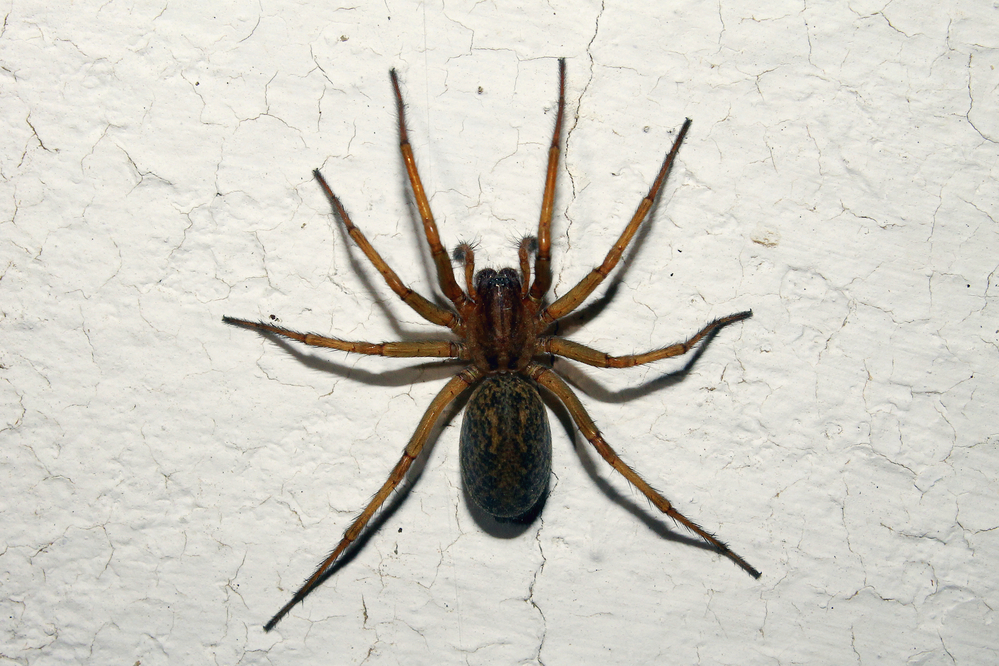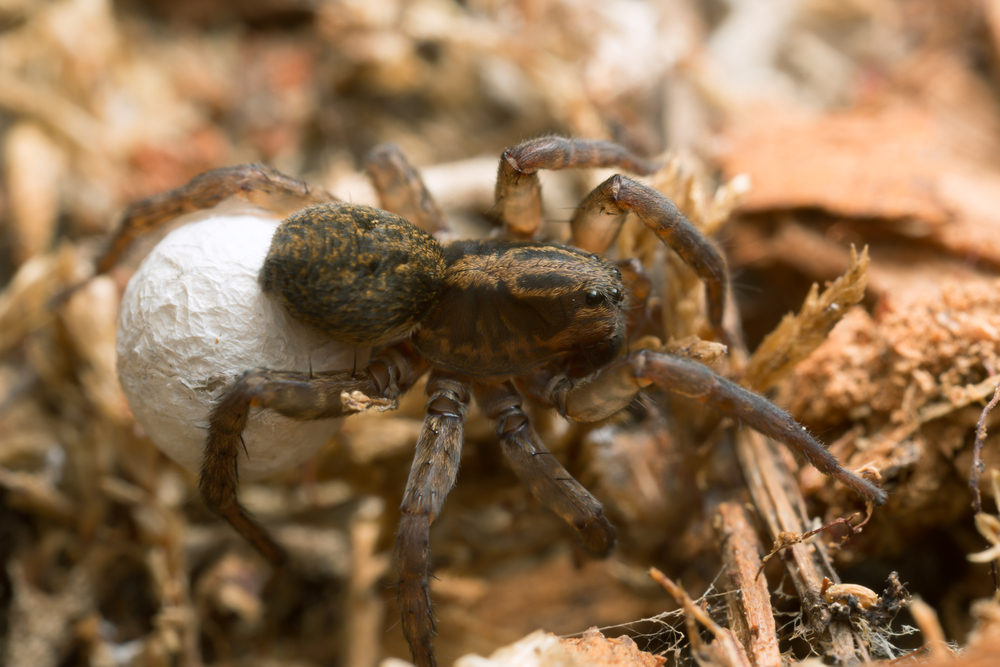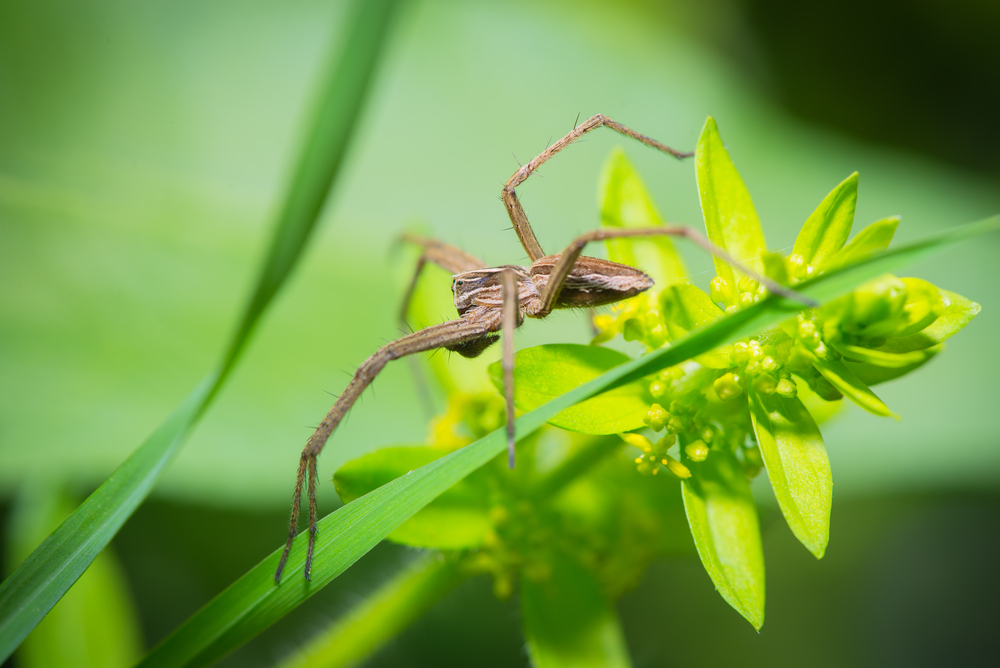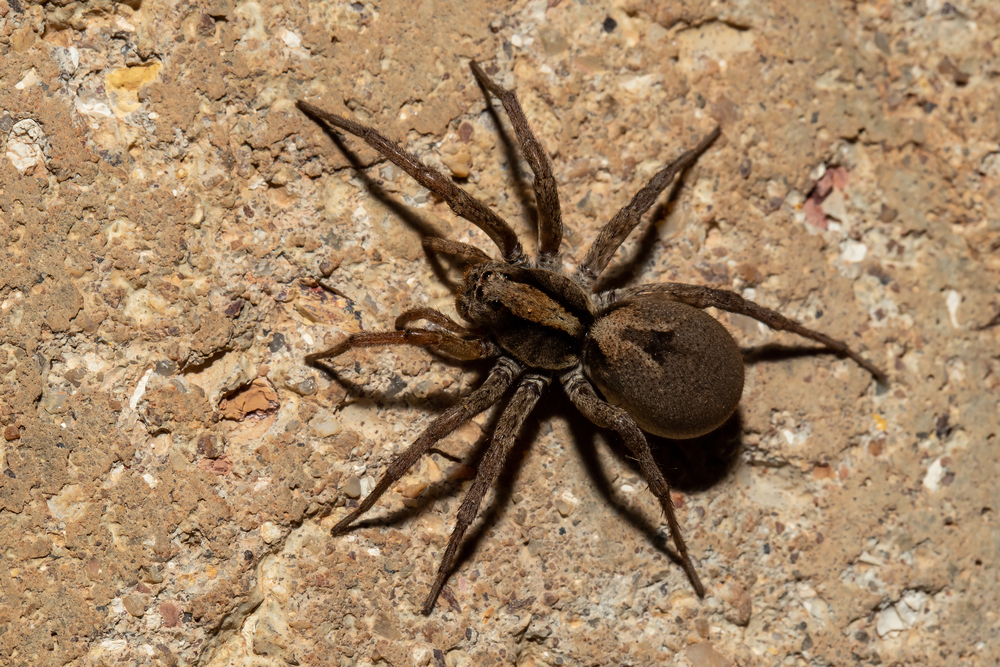Wolf spiders (Lycosidae) are a common species of arachnid found in the UK, yet many people know little about them. These nocturnal hunters can be identified by their distinctive colouring and markings, but what else do we know about the UK wolf spider? Their behaviour is surprisingly complex, they have adapted to different habitats across the country and, while venomous, pose no threat to humans. Despite this, there has been an alarming decline in numbers recently, leading us to ask: what does the future hold for these fascinating creatures? To answer that question, we must first understand more about wolf spiders, so let’s take a look at their identification traits, behaviours, habitats and conservation status.
How To Identify a Wolf Spider

Wolf spiders can range from 2 to 35mm in size and have a distinctive patterned body that is usually brown or greyish-brown in colour. Wolf spiders have eight eyes arranged into three rows; two large eyes at the top, four medium-sized eyes on either side of these and two small eyes below them.
Their legs are long and spiny, allowing them to move quickly through their habitats which include grasslands, woodlands, meadows and heaths. The abdomen is often marked with stripes or spots that help camouflage it against its environment. Some species may also have an iridescent sheen on their bodies due to light reflecting off tiny hairs covering their exoskeleton.
Identifying a wolf spider in the UK can be done by looking for its distinct markings, size and colour. Knowing how to identify these spiders is an important step towards understanding their behaviour and habitat requirements.
Wolf Spider Behaviour

Hunting
Wolf spiders do not build webs but instead hunt actively for prey such as insects, other arachnids and even small vertebrates like lizards or mice, using ambush tactics or chasing after them if necessary. They have excellent eyesight and use this to detect movement from potential prey. When they spot something, they quickly move towards it and pounce on it with their front legs before biting it with their fangs. They use venom to subdue their prey before consuming it whole using powerful jaws called chelicerae.
Mating
Mating habits of wolf spiders involve the male finding a female and then using his pedipalps (small appendages near its mouth) to deposit sperm into her reproductive organs while she is still in her burrow. After mating, the female will lay up to several hundred eggs inside an egg sac which she carries around until they hatch. The young wolf spiders emerge as tiny versions of adults and disperse shortly after hatching, leaving the mother behind.
When not hunting for food or mating, wolf spiders spend most of their time hiding under rocks or logs during daylight hours when predators such as birds may be active; however, at night, they become more active again and begin searching for food once more.
Wolf Spider Habitats

Wolf spiders are found in a variety of habitats throughout the UK. They prefer open, grassy areas such as meadows and fields but can also be seen in woodlands, gardens and even inside buildings. Wolf spiders are nocturnal hunters, so they’re most active at night when they search for prey on the ground or climb vegetation to find food. During the day, wolf spiders hide under rocks or logs or take shelter in burrows that they have dug themselves.
In terms of climate, wolf spiders thrive best in warm temperatures with plenty of moisture and humidity. In summer months, you may see them out during the day as well as at night due to increased warmth and activity levels. In winter months, however, wolf spider activity decreases significantly due to colder temperatures which force them into hibernation until spring arrives again.
When it comes to identifying where a wolf spider is likely to be found within its habitat range, several key factors should be taken into consideration: soil type (clay-based soils tend to provide more suitable conditions), vegetation cover (woodland edges with thick shrubs/bushes provide ideal hunting grounds) and nearby water sources (such as ponds). All these elements combined create an environment where a wolf spider can easily hunt for prey while remaining hidden from potential predators.
If you’re looking for a place to spot a wolf spider, then meadows and fields are the best bet, especially during warmer months when their activity levels increase.
Wolf Spider Venom
The venom produced by wolf spiders varies between species but generally has similar effects – pain, swelling at the site of injection, along with nausea and vomiting if enough venom was injected into your system via a bite. These symptoms usually subside within 24-48 hours without medical intervention unless severe allergic reactions occur, which would require immediate attention from medical professionals due to the risk associated with anaphylactic shock caused by exposure to certain proteins contained within the venom.
Conservation Status

The conservation status of wolf spiders in the UK is generally considered to be good. They are not listed as endangered or threatened species and have a wide distribution across Britain, with populations found in most areas. However, they may face threats from human activities, such as habitat destruction due to development and agricultural practices, pollution, and climate change.
Habitat destruction can reduce the amount of suitable habitat available for wolf spiders to live in. For example, deforestation can lead to a decrease in food sources for them and an increase in competition from other species that are better adapted to living in disturbed habitats. Additionally, urbanisation can also reduce their numbers by fragmenting their habitats into smaller patches which makes it difficult for them to find mates or resources necessary for survival.
Pollution is another threat faced by wolf spiders due to its ability to contaminate water sources and disrupt natural cycles within ecosystems like nutrient cycling or predator-prey relationships. Pesticides used on farms near spider habitats could also negatively affect their populations if they contain chemicals toxic enough to kill off individuals or entire colonies of these arachnids.
Finally, climate change poses a major risk since it has been linked with increased temperatures which may cause changes in rainfall patterns leading to droughts that could further degrade existing spider habitats while making new ones unsuitable for colonisation by this species.
FAQs In Relation To Wolf Spiders
Do wolf spiders bite?
Yes, wolf spiders can bite. They are common throughout Britain and Ireland, and they have venomous fangs that can penetrate human skin. However, their bites are usually not dangerous to humans as their venom is relatively weak. In most cases, according to webMD, a wolf spider bite will cause only minor pain or discomfort at the site of the bite, which should heal within a few days without any medical treatment being necessary.
How big are UK wolf spiders?
UK wolf spiders are typically between 8 and 20 mm in length. They have dark brown or black bodies with light markings on their abdomen. Their legs can be up to twice the size of their body, giving them an impressive appearance when seen close-up.
Can wolf spiders infest a house?
Wolf spiders can infest a house, although it is not common. They typically enter through small cracks and crevices in the walls or foundation of the home. If they find suitable conditions inside, such as food and shelter, they may stay for an extended period of time. To prevent wolf spider infestation, make sure to seal any potential entry points around your home and keep clutter away from walls and foundations. Regularly cleaning and vacuuming can also help reduce the chances of an infestation.
Conclusion
Wolf spiders have a wide range of habitats, behaviours and venom levels which make them fascinating to observe. It is important to remember that they should not be handled as their venom can cause harm; however, with careful observation, it is possible to appreciate these creatures without putting yourself at risk. Conservation efforts are ongoing for wolf spiders in the UK, and understanding more about them will help us protect this species for future generations.
Additional Resources

Ash is a contributing author who has been writing about wildlife for as long as he can remember. He has a vast knowledge of many different types of animals, from the tiniest shrews to the great whales that live in the deepest oceans.

Good afternoon. How do I fight them in the greenhouse? There are thousands of them there.
Regards Diana
Hi Diana, I would recommend contacting a local pest controller to deal with the infestation. Kind Regards
Found one in my garden today when clearing it. Wouldn’t have noticed it otherwise except it was carrying a white sac around. Now I cant sleep for worrying the babies are gonna get in my house. I live in Scotland so hardly a warm environment for them lol.
Do not kill them leave them or if u don’t want them around your house because of your arachnophobia or whatever then get signal boxes that emit a sound only audible to pest etc, but spiders are good for keeping insects at bay in your house especially mosquitos and knats that can cause more of a bite and possibly malaria from a mosquito. Man up and don’t be scared they will come nowhere near u they are more frightened then you are of them
I have re-occurring bites that look like ones from a wolf spider. I live in the UK. Itching started after I was working in a section of the garden I haven’t touched for years as it didn’t need it until recently when I had to rebuild a small rock retaining wall. This was mid may. Taking antihistamine tablets only eases the itching for a few days & I still keep getting the bites. I am not aware of spiders on me. Any thought?
Hello Diana,
It’s possible you’re not experiencing spider bites, but rather an allergic reaction from disturbing an old garden area, which could stir up allergens like moulds or pollens. The UK has a few types of wolf spiders, but they’re generally not a major biting threat. Instead, other garden insects or even plants might be causing skin irritations mistaken for bites. If you’re still facing issues months after the initial exposure, there could be an ongoing source or a persistent dermatological condition from the initial contact.
To address the itching, antihistamines and over-the-counter hydrocortisone cream can be beneficial. However, if these only provide temporary relief, it’s advisable to consult with a GP or dermatologist.
Kind Regards
thanks, i initially thought that i might have stirred up something in the earth as my calves began to get really itchy within hrs. i did discuss with GP a few weeks ago & she gave me cream which wasnt as effected as pills, will speak to her again soon. it was only on searching for the peculiar pattern of some of the bites , ie 2 very close pricks that i came up with the spider & then your site. otherwise i have been exposed to the usual garden soils & creatures , but havnt had to go back to the original area. my original suspicion is that there was still something in the soil.
thanks for your reply